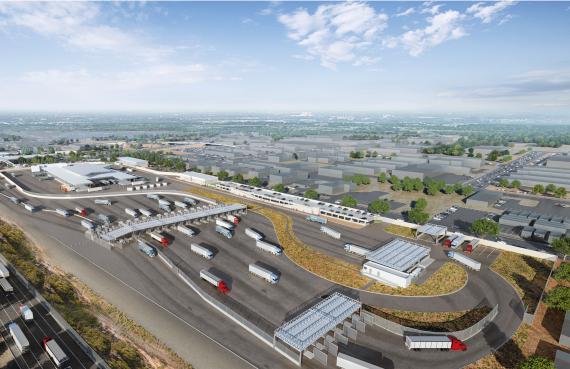Otay Mesa LPOE Modernization Boosts Regional Economic Development

Ever wondered about the return on the $144 million investment GSA is currently making in the modernization and expansion of the Otay Mesa Land Port of Entry (LPOE)? One way to assess the impact is the billions of dollars of goods which are imported into the United States from Mexico each year at the busiest commercial land port in California.
“The Otay Mesa LPOE is a major driver of economic opportunity for the United States and the San Diego region,” said R9 LPOE Program Manager Anthony Kleppe. “This investment allows the port to better serve businesses and workers who depend on the timely movement of goods between our two nations.”
Another assessment point are figures from the Department of Homeland Security - U.S. Customs and Border Protection (CBP) which shows an increasing number of cargo trucks crossing at Otay Mesa – 958,766 in Fiscal Year (FY) 2019, and 1,015,646 in FY 2021. Though truck crossings dipped by 51,221 (907,545) in FY 2020 as the pandemic raged, the crossings increased by more than 108,000 trucks last year. Translated into dollars, those trucks imported $34 billions of goods in FY19, $32 billion in FY20, and more than $37 billion in FY21.
“The improvements GSA is making continue to speed the importation of just-in-time shipments into the U.S., reduce wait times and vehicle emissions, and improve the supply chain by eliminating long-standing vehicular conflicts within the facility that have hampered commercial flows for decades,” said Kleppe.
Once complete, the Otay Mesa modernization and expansion project will provide the port tenants, including CBP and other federal agencies, with adequate operational space to reduce traffic congestion via a more efficient layout for port operations and the traveling public. To accommodate the one million trucks and 3.6 million pedestrians who cross each year, GSA is increasing commercial import lanes from nine to 16 and doubling pedestrian lanes from six to 12 to improve processing capacity.
The project, slated for completion in Spring 2023, also adds sustainability features and other upgrades and reconfigurations including those for commercial trucks, pedestrian travelers, employees, visitors, and bus inspections. A new, recently opened pedestrian bridge is now better connecting travelers to a nearby transit hub.
“Otay Mesa and especially the cargo port are the most-important asset for our community,” said Alejandra Mier y Teran, executive director of the Otay Mesa Chamber of Commerce. “Through this pandemic, Otay is one of the few communities in the wider San Diego community that never really closed between Baja and Southern California. Trade has increased.”
According to Mier y Teran, 80-90 percent of pedestrians crossing at Otay Mesa are essential workers, and feedback she continues to receive from small-business owners and human-resources directors applauds the pedestrian processing that’s key to keeping high-demand manufacturing facilities open including those producing medical devices and automotive parts.
“For essential workers and the high-demand transporting of perishable goods, this port is making a difference,” said Mier y Teran.
And why is this continued investment, modernization and expansion at Otay Mesa important to the citizens of the United States? According to CBP, among the most imported agricultural products transiting through Otay Mesa are peppers (chili and bell peppers), berries (blackberries, blueberries, raspberries and strawberries), tomatoes, tomatillos, squash and cucumbers.
“The changes GSA is making at the Otay Mesa LPOE will help this and future generations of American workers,” said Kleppe.

 U.S. General Services Administration
U.S. General Services Administration